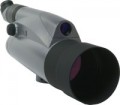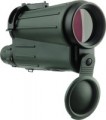Magnification
The magnification of the image provided by a telescope. Roughly speaking, this parameter describes how many times the object seen in the eyepiece of the pipe will be larger than when viewed from the same distance with the naked eye.
Multiplicity — the first number (numbers) in the digital marking of optical instruments: for example, the designation 25-75x50 corresponds to a multiplicity from 25x to 75x. Note that most modern telescopes have variable (adjustable) magnification. This allows you to choose the mode of operation depending on the situation: to search for the desired object, it is more convenient to reduce the magnification, providing a wide field of view, and having found it, increase the magnification and examine in detail. However in some models, to change the magnification, you need to replace the eyepiece (see "Replacement eyepiece").
High magnification, on the one hand, makes the tube "long-range" and makes it easy to examine small objects at considerable distances. On the other hand, the angle of view decreases in this case, which makes it difficult to observe moving objects and even aim the optics at the target. In addition, with an increase in the magnification, the diameter of the exit pupil also decreases (see below) and the aperture ratio of the tube; you can compensate for this moment by increasing the lens, but this accordingly affects the price. So it makes sense to specifically look for powerful optics with a high degree of ma...gnification only when such capabilities are fundamentally important.
Field of view 1 km away
The field of view of the telescope at a distance of 1 km to the objects under consideration, the so-called "linear field of view". In fact, this is the width (diameter) of the space that falls into the field of view when observed from a distance of 1 km.
This parameter is widely used in the characteristics of telescopes along with the angular field of view (see below): the linear field of view data is more visual and closer to practice, it allows you to evaluate the capabilities of a telescope without resorting to special calculations.
For models of variable magnification (the majority of them), the linear field of view is indicated in the form of two numbers — for the minimum and for the maximum magnification.
Angle of view
Angle of view provided by a telescope.
If you draw two lines from the centre of the lens to two opposite points along the edges of the field of view of the pipe, the angle between these lines will correspond to the angular field of view. Accordingly, the larger the angle, the wider the field of view; however, individual items in it will look smaller. Conversely, an increase in magnification is inevitably associated with a decrease in the viewing angle. And since most modern telescopes have a variable magnification, the angular field of view is also variable, and in the characteristics this indicator is indicated in the form of two numbers — for the minimum and for the maximum magnification.
Lens diameter
The diameter of the objective is the front lens of the telescope. The term "aperture" is also used for this characteristic.
The lens diameter is one of the most important characteristics of an optical system: the amount of light entering the lens and, accordingly, the image quality (especially in low light) directly depend on the aperture. From the point of view of optical characteristics, we can definitely say that the
larger the lens, the better, especially at high magnification (for more details, see “Exit Pupil Diameter”). On the other hand, large lenses significantly affect the size, weight, and most importantly, the cost of telescopes. Therefore, manufacturers usually choose the lens size taking into account the magnification, price category and the specifics of the use of a telescope — especially since at low magnifications and good lighting, even a relatively small aperture may well provide a high-quality image. For more information about these patterns, see "Exit Pupil Diameter". In addition, it is worth noting that the features of the "picture" are affected not only by the mathematical characteristics of the optics, but also by the overall quality of its components.
Exit pupil diameter
Exit pupil diameter of a spyglass.
The exit pupil is the projection of the image "seen" by the tube that appears just behind the eyepiece. A person sees an image in a telescope precisely due to the fact that the exit pupil is projected onto the eye.
The exit pupil diameter corresponds to the size of the lens divided by the magnification (see above for both). For example, for a pipe with an aperture of 50 mm, operating at a magnification of 25x, this size will be 50/25 = 2 mm. At the same time, it is believed that in order to ensure the most bright and comfortable image, the exit pupil should be no smaller than the pupil of the observer's eye — and this is 2-3 mm in the light and up to 8 mm (in the elderly — up to 5-6 mm) at dusk. This is the reason why for comfortable work at high magnifications and/or in low light conditions, a telescope must have a fairly large lens. However, most of these optical devices are designed for daytime use, and for this, an exit pupil of 1.33 mm in size is sufficient.
For most modern telescopes, the exit pupil diameter is indicated by two numbers — for the minimum and for the maximum magnification.
Eye relief
Removal of the exit pupil of a telescope.
About the exit pupil itself, see above. Here we note that the offset is such a distance from the eyepiece lens to the observer's eye, at which the size of the visible image from the lens corresponds to the visible size of the eyepiece lens. In other words, the observed "image" in this case occupies the entire space of the eyepiece, without vignetting (darkening at the edges) and without "spreading" beyond the edges of the eyepiece. In this case, the overall image quality will be the best.
When looking down the pipe with the naked eye, the observer usually has no problem getting into the offset distance, and this parameter can be ignored. Problems can arise if the user wears glasses and the diopter adjustment (see above) is not sufficient to comfortably view without glasses. In such cases, it is desirable to use models with eye relief of at least 15 mm: although such a distance will not provide the highest image quality when viewed with glasses, it will allow using the device without any special difficulties. However, in modern telescopes, this parameter can reach 18 mm or even more.
Also note that eye relief may decrease somewhat with increasing magnification; in such cases, two numbers are indicated in the characteristics, corresponding to the removal at the minimum and at the maximum magnification.
Eyepiece location
The location of the eyepiece relative to the body (more precisely, relative to the optical axis) of the tube.
—
Direct. In this case, the eyepiece is directed parallel to the optical axis of the tube — in other words, it "looks" in the same direction as the lens. In this case, the eyepiece can be directly on the optical axis or above it. The direct arrangement is convenient especially in those cases when the tube is used without a tripod and is held in the hands. It is well suited for observations from a shelter (for example, during hunting or wildlife research) — the observer does not need to rise above the body of the tube to look into the eyepiece. Also, this option is easier for novice users who have not previously dealt with optical instruments — it is more convenient to point the pipe at the target. In addition, when the eyepiece is located on the same axis as the lens, prisms can be dispensed with, which simplifies the design (although this arrangement in itself does not mean the absence of prisms).
—
Under 45°. An eyepiece bent upwards by 45° relative to the optical axis of the tube. In many situations, this arrangement is more convenient for the observer. For example, it allows you to comfortably use a relatively low tripod (whereas a tube with a straight eyepiece must be placed at eye level, that is, either look for a high tripod or squat to the level of the eyepiece). In add
...ition, for similar reasons, curved eyepieces are more convenient when observing objects above the horizon and celestial bodies. The disadvantage of this design is the unequivocal need to use Porro prisms (see "Prism type"), which can affect the cost. In addition, for a person without experience, aiming a curved pipe at the desired object can, out of habit, be quite a difficult task.Prism type
The type of prisms used in the construction of the telescope (if prisms are provided at all).
—
Roof. A Roof prism does not change the direction of light entering it — the light beam goes through several internal reflections and exits in the same direction and at the same level as it entered. Such prisms are used in models with a direct arrangement of the eyepiece; they allow you to increase the focal length of the telescope and achieve high magnification without a significant increase in the length of the device itself.
—
Porro. A classic prism of this type provides a "reversal" of the light entering it by 180 °; because of this, Porro are used at least in pairs. They are used in almost all telescopes with eyepieces located at 45 °, as well as in "straight" models, in which the eyepiece is offset relative to the optical axis of the lens (usually upwards). For the advantages of the first option, see "Eyepiece Positions"; and placing the eyepiece above the lens reduces the length of the telescope, moreover, in some situations, this arrangement is the most convenient. Like the Roof, Porro prisms provide an increase in focal length; however, they are considered to give a wider field of view and good image depth. The disadvantage of this option is the increase in the dimensions of the pipe in height.
Prism material
The material used for prisms mounted in a telescope (see "Type of Prisms").
—
BK7. A variety of borosilicate optical glass (crown), a relatively inexpensive and at the same time quite functional material that provides, although not outstanding, but quite acceptable image quality. It is used in models of initial and intermediate levels.
—
BaK4. Barium optical glass, which is noticeably superior to BK7 in terms of brightness and image clarity, but also more expensive. Found mainly in premium spyglasses.

